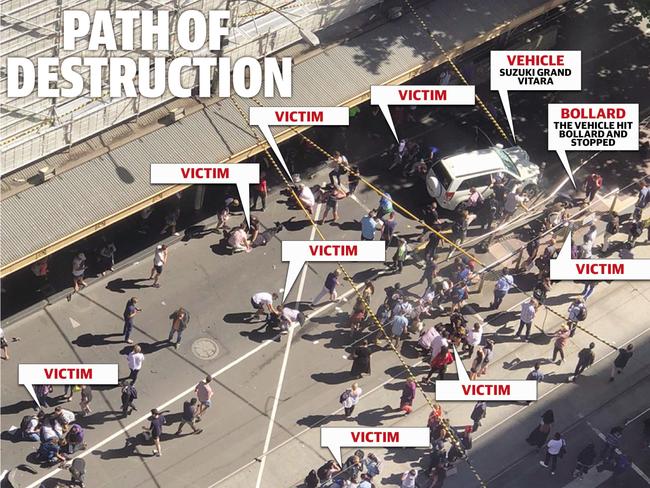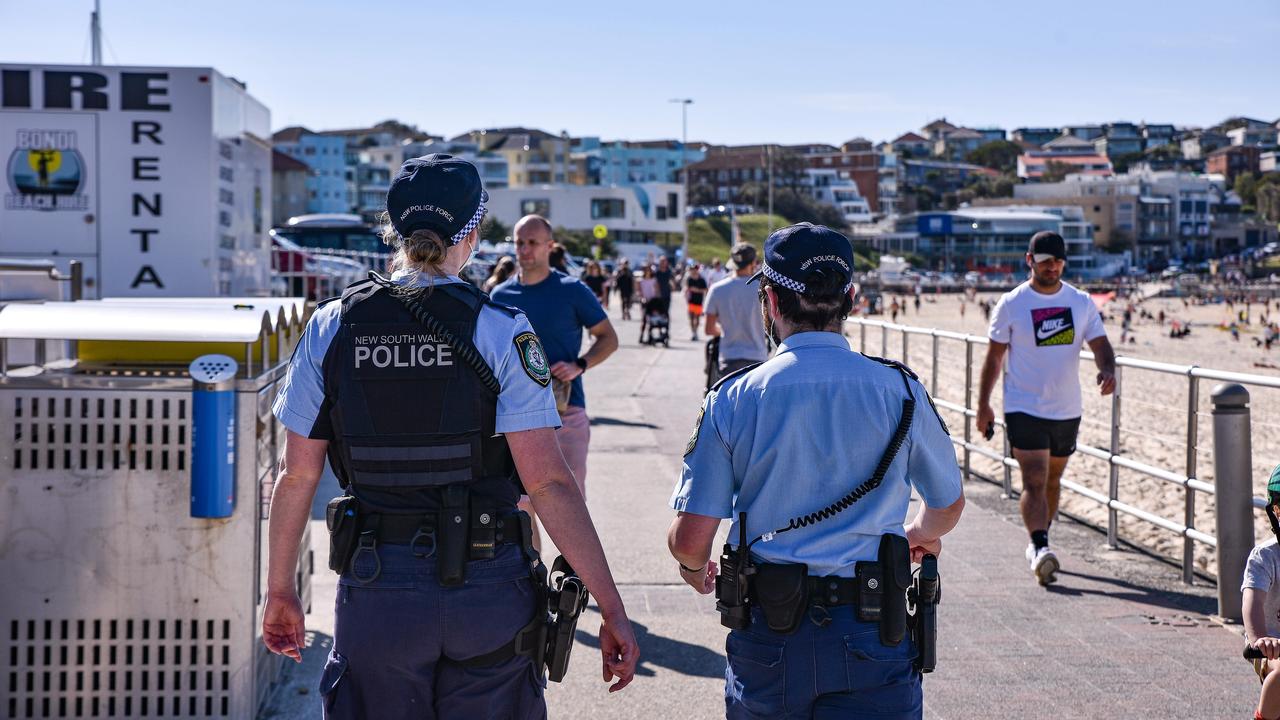Melbourne carnage: ‘all you could hear were the screams ...’
They heard it before they saw it. The whine of a car engine, inexplicably accelerating when all other traffic had come to a stop.
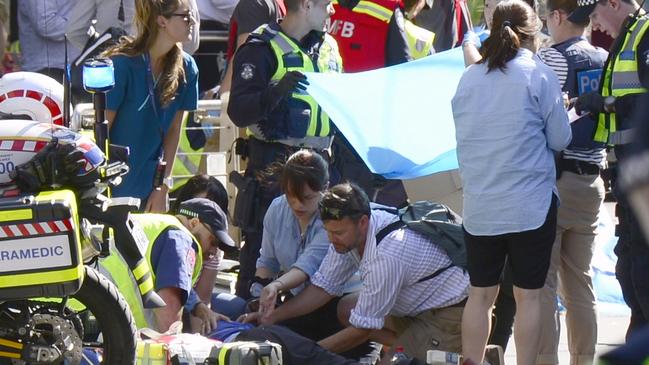
They heard it before they saw it.
The whine of a car engine, inexplicably accelerating when all other traffic had come to a stop.
The shouts and screams of people who seconds before had been thinking about getting home from work or heading into the city to shop for Christmas presents or merely enjoying the warmth of the late afternoon sun.
The white Suzuki Vitara had a P-plate in its window. The driver, for reasons that may never be clear, was gripped with murderous intent.
As he approached a red light at the busiest T-intersection in the city — where Flinders Street meets Elizabeth Street outside Melbourne’s central train station, where trams stop and cars and trucks jostle and people cross on foot in their tens of thousands every day — he made no attempt to brake.
Instead, he put his foot to the floor, gunning his boxy four-wheel-drive into the mass of pedestrians.
Then he accelerated again to maximise the carnage.
Bodies were sent flying, landing on the hard asphalt with a sickening thud.
One of them was a little boy, not yet at primary school. Last night he was in the Royal Children’s Hospital with serious head injuries. Police said 19 people were injured; four are critical.
Police believe this was a deliberate attack. No one who saw it would argue.
Jim Stoupas watched the horrific scene unfold just metres away from where he stood on the kerb. He had stepped out from behind the counter of his Walkers Doughnuts store to help a drug-addled passer-by when he saw the white Suzuki speeding towards the pedestrian crossing.
“The intersection was completely choked … it just barrelled through the pedestrians,’’ Mr Stoupas told CNN.
“The only thing that I think slowed it down was just the volume of pedestrians that he hit.
“It was just pandemonium. All you could hear were screams and people bouncing off the car. It was awful. There was no braking, no attempt to slow down.’’
Another witness, 20-year-old Lachlan Read, described a scene of mayhem.
“He has gone straight through the red light at pace and it was bang, bang, bang,” Mr Read told the Herald Sun. “It was just one after the other.’’
Sue Nicolaidis was also working at Walkers Doughnuts. She heard the sound of the racing engine and turned to see the car ram into unsuspecting pedestrians.
“There was just people on the ground, not moving, people screaming — it is just like a nightmare,” Ms Nicolaidis said.
She described how the car finally careered into a tram stop, its bonnet crumpling around a steel bollard. The driver, a man with dark hair and a beard, was pulled from the wreckage by police.
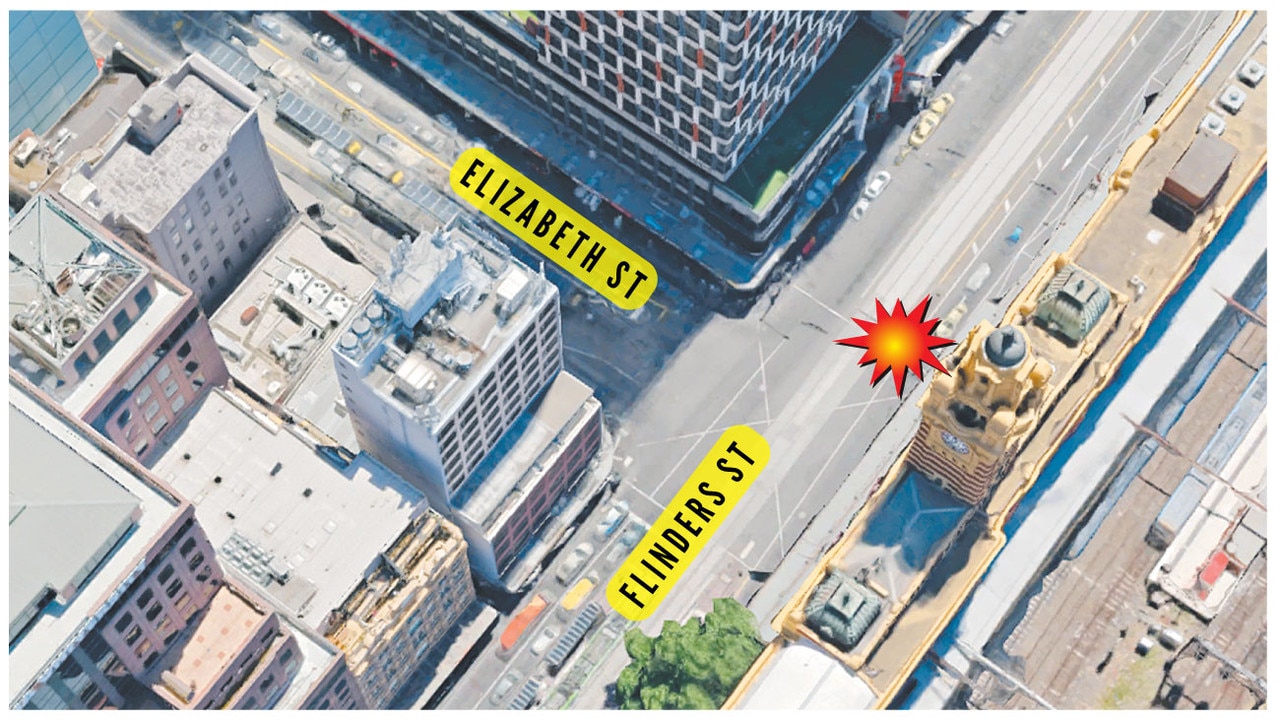
Lachlan Vella, who filmed the arrest on his mobile phone, said the man appeared to be unconscious when police reached him. “They were trying to wake him up,’’ Mr Vella told The Australian. “They had a gun pointing at his chest.”
When Mr Vella looked around, he saw the injured people scattered across the intersection.
“I saw a guy holding his head,” he said. “His head had been busted open. I saw another Asian man lying there, there was a pool of blood.’’
Police arrested a second man wearing a red checked shirt, also with a full beard. It is believed he had no involvement in the incident. As of last night, no charges had been laid.
Vince, a Flinders Street shopkeeper, said he ran to the crash site when he heard the commotion. By the time he got there, the street resembled a battlefield triage, with people lying on the ground and others doing their best to keep them calm.
Paramedics and firefighters arrived quickly to administer first aid. Victoria Police dispatched a critical incident response team, armed with semiautomatic rifles, to secure a perimeter.
Joint counter-terrorism team detectives also attended.
The heart of the city remained in lockdown last night, with the northern entrances to Flinders Street Station sealed, traffic diverted away from Flinders Street and Elizabeth Street and police barricading what is now a crime scene.
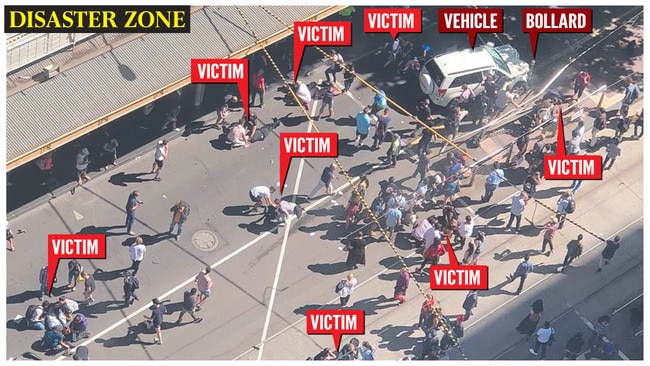
For a city still recovering from the Bourke Street tragedy in January, when six people died in an inexplicable vehicle attack, this latest outrage has brought a sickening feeling of deja vu.
It is only last week that police from around the English-speaking world gathered in Melbourne to discuss the latest counter-terrorism strategies and intelligence, including how to defend a city against vehicle-borne attack. Melbourne is already doing what it realistically can. Since Bourke Street, 440 concrete blocks have been distributed around the city to stop cars and trucks from crashing into popular gathering places. Bourke Street Mall is protected by 20 bollards, concrete planter boxes and fortified street furniture moored into crash-proof footings.
Police do not believe the driver responsible for yesterday’s attack is a terrorist. Rather, they think he is an erratic ice addict with a history of mental illness.
To those who stepped into a sunny street yesterday with no inkling that their Christmas was about to be ruined, to those now recovering from broken legs and fractured ribs and split skulls and worse, to those who may not recover, it makes little difference why he did what he did.
Not for the first time and, more than likely, not for the last, a city is left angry, confused and deeply wounded that such a thing could happen.
Additional reporting: Richard Ferguson, Tessa Akerman, Ewin Hannan

